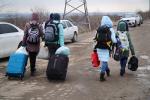
Sexual Violence and the War in Ukraine
As war in Ukraine continues to unfold, disturbing stories of suffering have been reported by media across the globe. One aspect of the conflict that is increasingly under scrutiny is reports of sexual violence and rape levelled at Russian soldiers by Ukrainian women and children. These accounts of sexual violence and rape have received increasing attention since the first reports of sexual violence being perpetrated by Russian or pro-Russian soldiers began to appear in early April. Additionally, verified reports of sexual violence against men and boys are emerging. The UN warned that the current knowledge we have about sexual violence in Ukraine represents only the “tip of the iceberg” and it is likely that many more reports will emerge throughout the duration of the war.
These accounts of sexual violence are grim and widespread. Women have spoken of harrowing assaults, including gang rapes, repeated rapes, and fear of being raped. According to Ukraine’s ombudswoman for human rights, following the Russian withdrawal from Bucha, two dozen women were “systematically raped” by Russian forces. This apparent systemisation indicates that rape is being incorporated into military strategy in Ukraine and is being used to terrorise communities and individuals.
Rape as a weapon of war
Looking at the patterns of rape emerging in Ukraine paints a worrying picture that has echoes of atrocities perpetrated in Bosnia-Herzegovina in the early 1990s. In Bosnia-Herzegovina, an estimated 20-50 000 women and girls were raped during the conflict. Indeed, rape and sexual violence were used as strategic, explicit weapons of war and genocide with the aims of humiliating, threatening, intimidating and terrorising communities. Rape was also used in Bosnia-Herzegovina with the aim of impregnating women with children from the perpetrator group, a clear and intentional act of genocide aiming to reshape the future of the country.
Indeed, the terminology of genocide transcends acts of killing and includes acts that aim to destroy the social and cultural fabric of a particular group of peoples. We can see this through the perpetration of sexual violence in Bosnia-Herzegovina where rape was used as a form of ethnic cleansing and genocide: both as a threat against people forcing them to leave their homes, and also with the explicit aim of making Bosnian Muslim women become pregnant with children who were half Bosnian Serb. This is particularly relevant in contexts where the family line is patriarchal, and is carried by the father’s lineage - as is the case in Bosnia-Herzegovina.
What motivates the perpetrators?
While the intentions motivating the widespread rapes across Ukraine are not, and perhaps never will be, known, the patterns and allegations of gender-based violence emerging from the country indicate that this is more than opportunistic violence. Individual perpetrators can be motivated to commit violence for a number of different purposes: ideological reasons, to foster a sense of belonging and respect within the perpetrator group, to assert dominance and hierarchy, among others. However, what we are witnessing in Ukraine is a widespread perpetration of violence indicating that individual soldiers are not deciding to commit sexual violence alone, and that the violence is at least ignored and at worst condoned or encouraged by the upper leadership.
Looking to other recent conflicts involving Russian militaries - namely, Chechnya and the annexation of Crimea - we see evidence of the widespread perpetration of sexual violence by Russian armed forces and pro-Russian forces indicating that this is a common practice within the Russian army. During the Crimean war, sexual violence against men was also used as a method of torture and to force people from their homes.
Justice for victims
Achieving justice for these forms of crimes is notoriously difficult. Not least because the victims themselves are often reluctant to discuss their trauma - sometimes until years after the abuse has occurred. Additionally, documentation of the crimes is proving extremely challenging, particularly because these attacks are happening in an active conflict zone so it is hard for relevant NGOs and fact-finders to reach the victims.
The UK recently spearheaded an initiative to send investigators to Ukraine to gather evidence of war crimes, including sexual violence. The International Criminal Court has also recently opened an investigation to examine the situation in Ukraine from 2013 to present. This is perhaps the first step to being able to understand what is happening on the ground and provide concrete evidence of crimes. In addition, the US have launched Mobile Justice Teams to examine “horrific accounts of sexual violence against women and girls,” while this is a good start to finding out what is going on, it ignores the evidence of sexual violence that is being perpetrated against men and queer people.
In the case of Bosnia-Herzegovina, these initial investigative trips and the overwhelming evidence of war crimes and crimes against humanity led to the creation of the International Criminal Tribunal for the former Yugoslavia. However, these missions take time to compile evidence and verify facts. It will be a long time before we know precisely what is happening during the conflict in Ukraine.
Anna Gopsill, PhD candidate at the School of Advanced Study, Institute of Commonwealth Studies (University of London), researches the use, persecution and interpretation of sexual violence against men during the wars in former Yugoslavia and Rwanda. She was a NIOD research fellow during the academic year 2021-2022.